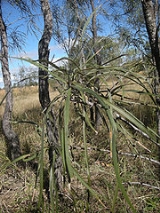
Grevillea striata
Encyclopedia
Grevillea striata, also known as Beefwood
, is a tree or shrub native to all Australia
n states, with the exception of Victoria
and Tasmania
. Alternative common names for this species include Western Beefwood, Beef Oak, Beef Silky Oak and Silvery Honeysuckle.
Creamy-yellow flowers are produced in cylindrical spikes predominantly from August to December in Australia (late winter to early summer) although they may appear at other times of the year.
These are followed by woody, beaked seed capsules which are about 1.5 cm long.
It is a long-lived tree. In New South Wales
, a tree still stands which bears an inscription in memory of a member of Charles Sturt
's expedition in 1845. James Poole, having died of scurvy
, was buried near the Beefwood tree at Preservation Creek near Milparinka
, and an inscription "JP 1845" was carved into the tree.
in 1810.
or Acacia
woodland and also in Triodia
- shrubland communities.
s as a cement and for medicinal purposes. Due to its durability and the fact that it splits readily, the timber was used in the past for fence posts and shingles. It is known as Beefwood due to the intense red colour of its heartwood.
Beefwood
Beefwood is the name given to a number of Australian trees which have timber with a red colouration resembling raw beef as follows:*Barringtonia calyptrata, also known as Cornbeefwood.*Barringtonia racemosa, also known as Cornbeefwood....
, is a tree or shrub native to all Australia
Australia
Australia , officially the Commonwealth of Australia, is a country in the Southern Hemisphere comprising the mainland of the Australian continent, the island of Tasmania, and numerous smaller islands in the Indian and Pacific Oceans. It is the world's sixth-largest country by total area...
n states, with the exception of Victoria
Victoria (Australia)
Victoria is the second most populous state in Australia. Geographically the smallest mainland state, Victoria is bordered by New South Wales, South Australia, and Tasmania on Boundary Islet to the north, west and south respectively....
and Tasmania
Tasmania
Tasmania is an Australian island and state. It is south of the continent, separated by Bass Strait. The state includes the island of Tasmania—the 26th largest island in the world—and the surrounding islands. The state has a population of 507,626 , of whom almost half reside in the greater Hobart...
. Alternative common names for this species include Western Beefwood, Beef Oak, Beef Silky Oak and Silvery Honeysuckle.
Description
The plant exhibits a range of growth forms, from a spindly shrub ~3m metres in height to a robust tree up to 15 metres. The trunk is covered in rough, brown, furrowed bark. The leaves are long, narrow and straplike, 10 to 45 cm long and up to 1 cm wide.Creamy-yellow flowers are produced in cylindrical spikes predominantly from August to December in Australia (late winter to early summer) although they may appear at other times of the year.
These are followed by woody, beaked seed capsules which are about 1.5 cm long.
It is a long-lived tree. In New South Wales
New South Wales
New South Wales is a state of :Australia, located in the east of the country. It is bordered by Queensland, Victoria and South Australia to the north, south and west respectively. To the east, the state is bordered by the Tasman Sea, which forms part of the Pacific Ocean. New South Wales...
, a tree still stands which bears an inscription in memory of a member of Charles Sturt
Charles Sturt
Captain Charles Napier Sturt was an English explorer of Australia, and part of the European Exploration of Australia. He led several expeditions into the interior of the continent, starting from both Sydney and later from Adelaide. His expeditions traced several of the westward-flowing rivers,...
's expedition in 1845. James Poole, having died of scurvy
Scurvy
Scurvy is a disease resulting from a deficiency of vitamin C, which is required for the synthesis of collagen in humans. The chemical name for vitamin C, ascorbic acid, is derived from the Latin name of scurvy, scorbutus, which also provides the adjective scorbutic...
, was buried near the Beefwood tree at Preservation Creek near Milparinka
Milparinka, New South Wales
Milparinka is a small settlement in north-west New South Wales, Australia about north of Broken Hill on the Silver City Highway. At the time of the 2006 census, Milparinka had a population of 55 people....
, and an inscription "JP 1845" was carved into the tree.
Taxonomy
The species was first formally described by botanist Robert BrownRobert Brown (botanist)
Robert Brown was a Scottish botanist and palaeobotanist who made important contributions to botany largely through his pioneering use of the microscope...
in 1810.
Distribution
It occurs as scattered trees in open EucalyptusEucalyptus
Eucalyptus is a diverse genus of flowering trees in the myrtle family, Myrtaceae. Members of the genus dominate the tree flora of Australia...
or Acacia
Acacia
Acacia is a genus of shrubs and trees belonging to the subfamily Mimosoideae of the family Fabaceae, first described in Africa by the Swedish botanist Carl Linnaeus in 1773. Many non-Australian species tend to be thorny, whereas the majority of Australian acacias are not...
woodland and also in Triodia
Triodia (plant genus)
Triodia is a large genus of hummock-forming grass endemic to Australia; they are commonly known as spinifex, although they are not a part of the coastal genus Spinifex. There are currently 64 recognised species...
- shrubland communities.
Uses
Sap from the tree was used by aborigineAustralian Aborigines
Australian Aborigines , also called Aboriginal Australians, from the latin ab originem , are people who are indigenous to most of the Australian continentthat is, to mainland Australia and the island of Tasmania...
s as a cement and for medicinal purposes. Due to its durability and the fact that it splits readily, the timber was used in the past for fence posts and shingles. It is known as Beefwood due to the intense red colour of its heartwood.

